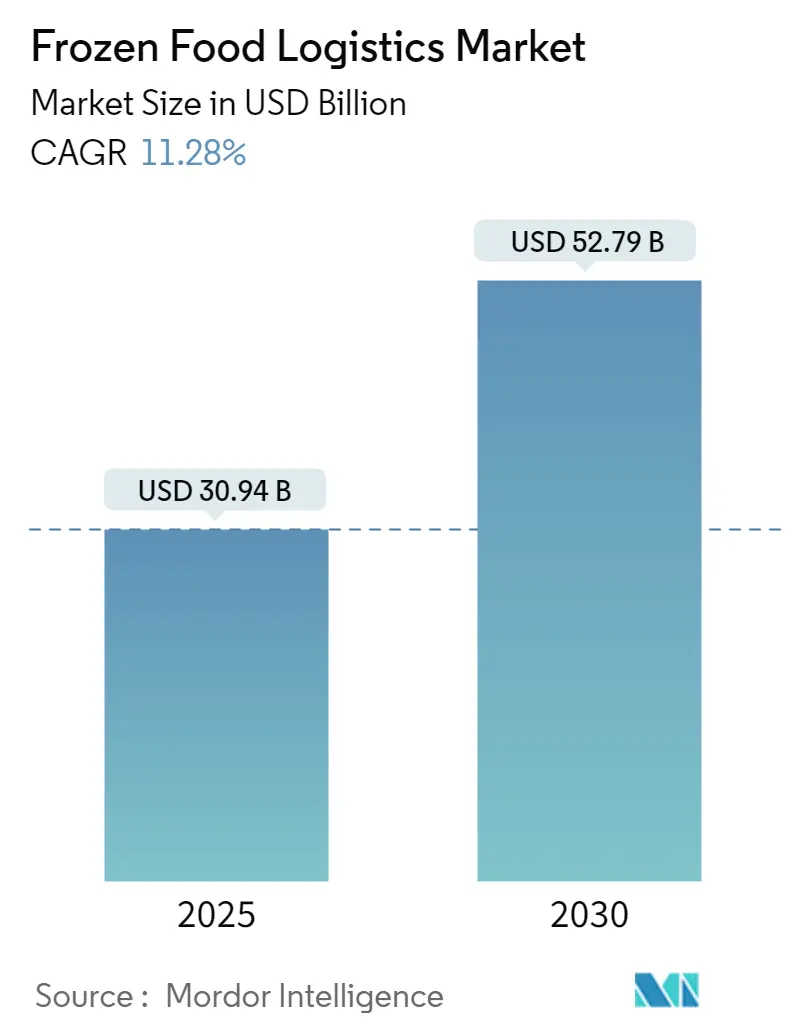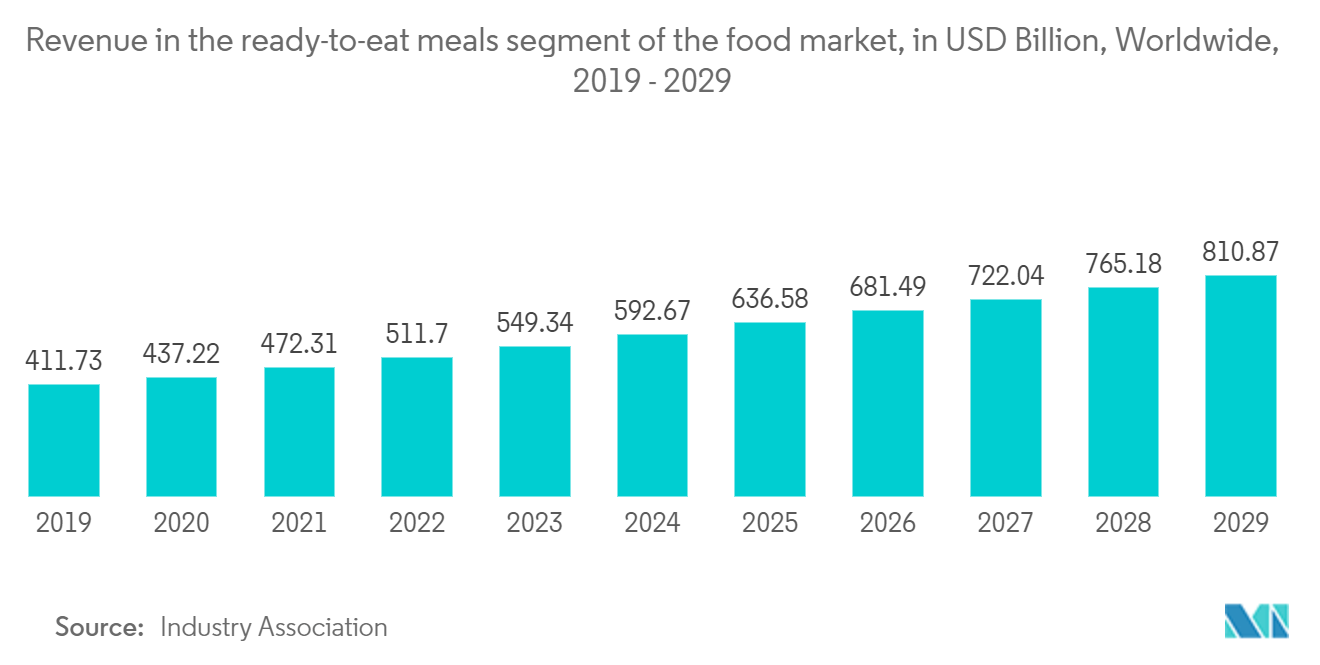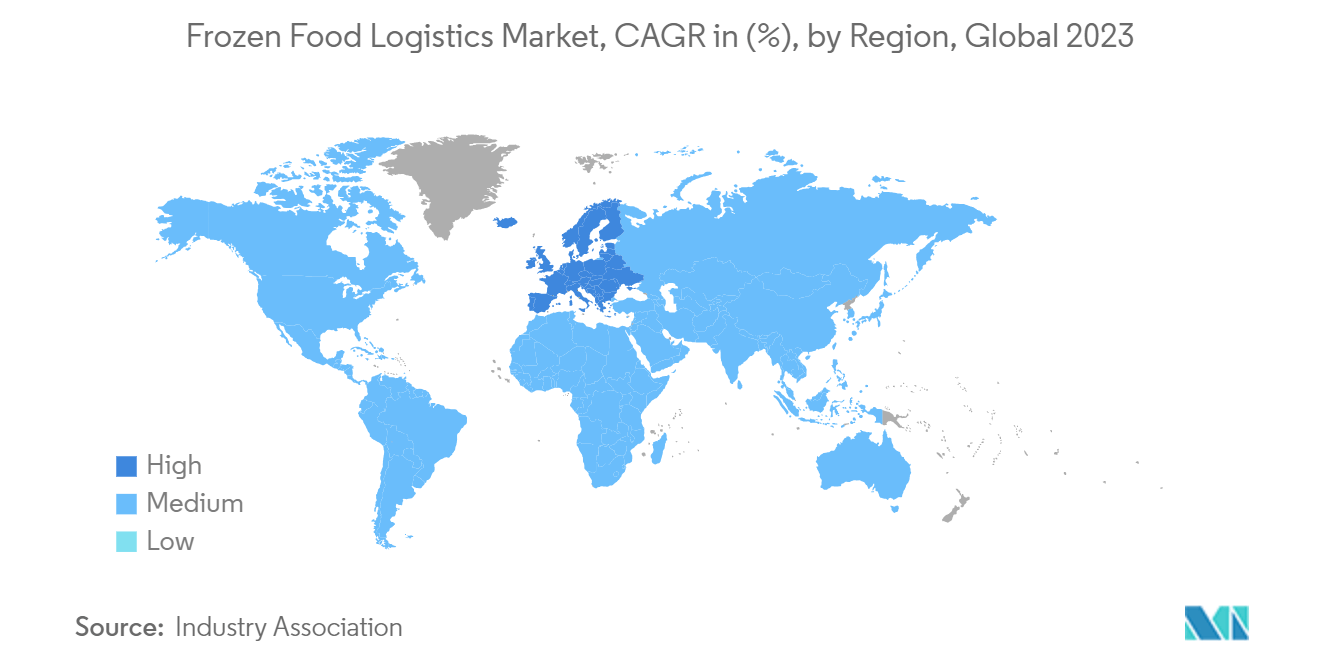Frozen Food Logistics Market Size and Share

Frozen Food Logistics Market Analysis by Mordor Intelligence
The Frozen Food Logistics Market size is estimated at USD 30.94 billion in 2025, and is expected to reach USD 52.79 billion by 2030, at a CAGR of 11.28% during the forecast period (2025-2030).
- A surge in demand for frozen food products and growing urbanization mainly drive the frozen food logistics market.
- Over the past few years, the premium frozen food industry has witnessed remarkable growth. A heightened consumer appetite for top-tier, convenient, and nutritious food choices predominantly propels this upsurge. This trend is especially pronounced among health-conscious individuals seeking balanced diets and the swiftness of ready-to-eat meals.
- Moreover, consumers increasingly acknowledge the superior quality of products made possible by modern freezing technologies, which effectively retain taste and nutritional value.
- Notably, affluent urban households are spearheading the sales of these premium frozen offerings. These products often boast gourmet recipes, responsibly sourced ingredients, and cutting-edge flavors.
- This surge in demand mirrors a broader consumer shift toward home cooking, culinary experimentation, and a desire for restaurant-grade meals—all enjoyed from the comfort of their homes. It is a trend tailored for discerning food enthusiasts unwilling to compromise on quality, taste, or nutrition.
- In 2023, retail sales of frozen foods surged by 7.9%, hitting USD 74.2 billion. This marked a notable USD 10 billion increase over the last three years, as highlighted in a recent report. Like many grocery segments, the growth of frozen food’s value in dollars was primarily fueled by inflation-driven price hikes.
- Consequently, consumer behavior toward frozen food is changing. The Power of Frozen in Retail 2023 report, a collaboration between the American Frozen Food Institute (AFFI) and the Food Industry Association (FMI), revealed that consumers shelled out an average of USD 4.99 per unit for frozen items. This represented a 13.5% uptick from 2023 and a substantial 29.6% leap in the last three years.
- Frozen meals and desserts are leading the pack in frozen food sales, raking in USD 26.6 billion and USD 15.4 billion, respectively, in 2023. These are followed by fruits/vegetables, seafood, and meat/poultry, each boasting sales figures of USD 8.1 billion, USD 7 billion, and USD 5.7 billion, respectively, in the same year.
Global Frozen Food Logistics Market Trends and Insights
Demand for Frozen Food Products Gaining Traction in the Industry
The ready-to-eat market has witnessed a significant evolution in recent years, driven by a surge in product innovation tailored to changing consumer preferences. This transformation is especially pronounced in India, where convenience and taste preferences are paramount.
Consumers are increasingly gravitating toward healthier, natural options in the ready-to-eat industry. This has increased demand for products with clean labels, minimal additives, and organic ingredients. Furthermore, there is a growing appetite for plant-based and vegan choices. As more individuals adopt plant-based diets or reduce meat consumption, the demand for plant-based or vegan-friendly ready-to-eat options is rising.
Key to the industry's growth is the unwavering commitment to innovation by both established players and startups. Recent research from Nielsen underscores a significant consumer pivot toward healthier ready-to-eat choices, particularly in India. The study indicates that 72% of Indian consumers actively seek nutritious, well-balanced, ready-to-eat meals, showcasing a heightened health consciousness.
In response, companies are harnessing technology and culinary skills to craft products that meet nutritional needs and cater to the diverse Indian palate. This includes the introduction of gluten-free, organic, and locally-inspired options.
Partnerships between ready-to-eat brands and nutrition institutes or experts are broadening product offerings and reshaping consumer perceptions, positioning ready-to-eat foods as a healthier meal choice.

Europe is Holding a Prominent Position in the Market
In 2023, Germany's total frozen food sales reached 4.043 million tonnes, marking a 3.4% increase from 3.909 million tonnes in 2022. This surge pushed sales past the 4-million-tonne milestone for the first time.
The out-of-home market saw a notable 6.5% uptick in sales, hitting 2.061 million tonnes in 2023, up from 1.935 million tonnes in 2022. This growth propelled the market past the 2-million-tonne threshold.
Within the food retail and home services industry, frozen food sales in 2023 reached 1.982 million tonnes, reflecting a modest 0.4% increase from 1.974 million tonnes in 2022. Notably, this figure stood 6.5% higher than the pre-COVID-19-pandemic levels in 2019, which were at 1.861 million tonnes.
Individually, per capita consumption of frozen food hit a record high of 49.4 kg in 2023, up from 47.7 kg in 2022. At the household level, consumption saw a 3 kg increase, reaching 99.4 kg in 2023, compared to 96.4 kg in 2022.

Competitive Landscape
The frozen food logistics market is fragmented in nature. Giants like Lineage Logistics, Americold Logistics, Swire Cold Storage, Nichirei Logistics, and VersaCold Logistics Services are leading the pack in the cold chain logistics industry.
These key players provide a suite of services, including temperature-controlled storage, transportation, and distribution, tailored to the specific needs of the frozen food industry. These companies have solidified their competitive edge in the market by leveraging expansive networks, cutting-edge technologies, and specialized know-how in frozen goods management.
Frozen Food Logistics Industry Leaders
-
Lineage Logistics
-
Americold Logistics
-
Swire Cold Storage
-
Nichirei Logistics
-
VersaCold Logistics Services
- *Disclaimer: Major Players sorted in no particular order

Recent Industry Developments
- April 2024: DACHSER was in the process of acquiring Brummer Logistik GmbH in Germany and Brummer Logistic Solutions GmbH & Co. KG in Austria. This acquisition will see DACHSER taking over the complete operational business of Brummer Group. While the exact purchase price remains undisclosed as per the agreement, the deal is pending approval from German and Austrian competition authorities.
- February 2024: Private equity investor Mutares SE & Co.KGaA announced the sale of Frigoscandia AB to DACHSER. This strategic move aims to enhance the geographic reach of DACHSER's European Food Network.
Global Frozen Food Logistics Market Report Scope
The frozen food logistics market refers to the transportation, storage, and distribution of frozen food products from production facilities to retail stores, restaurants, or end consumers. It involves managing temperature-controlled supply chains to ensure the safe and efficient delivery of frozen food items while maintaining their quality and freshness.
The frozen food logistics market is segmented by product category (ready-to-eat and ready-to-cook), product type (frozen fruits and vegetables, frozen meat and fish, frozen-cooked ready meals, frozen desserts, frozen snacks, and other product types), transportation (roadways, railways, seaways, and airways), and geography (North America, Europe, Asia-Pacific, South America, and Middle East and Africa). The report offers frozen food logistics market size and forecasts in value (USD) for all the above segments.
| Ready-to-eat |
| Ready-to-cook |
| Frozen Fruits and Vegetables |
| Frozen Meat and Fish |
| Frozen-Cooked Ready Meals |
| Frozen Desserts |
| Frozen Snacks |
| Other Product Types |
| Roadways |
| Railways |
| Seaways |
| Airways |
| North America |
| Europe |
| Asia-Pacific |
| South America |
| Middle East and Africa |
| By Product | Ready-to-eat |
| Ready-to-cook | |
| By Product Type | Frozen Fruits and Vegetables |
| Frozen Meat and Fish | |
| Frozen-Cooked Ready Meals | |
| Frozen Desserts | |
| Frozen Snacks | |
| Other Product Types | |
| By Transportation | Roadways |
| Railways | |
| Seaways | |
| Airways | |
| By Geography | North America |
| Europe | |
| Asia-Pacific | |
| South America | |
| Middle East and Africa |
Key Questions Answered in the Report
How big is the Frozen Food Logistics Market?
The Frozen Food Logistics Market size is expected to reach USD 30.94 billion in 2025 and grow at a CAGR of 11.28% to reach USD 52.79 billion by 2030.
What is the current Frozen Food Logistics Market size?
In 2025, the Frozen Food Logistics Market size is expected to reach USD 30.94 billion.
Who are the key players in Frozen Food Logistics Market?
Lineage Logistics, Americold Logistics, Swire Cold Storage, Nichirei Logistics and VersaCold Logistics Services are the major companies operating in the Frozen Food Logistics Market.
Which is the fastest growing region in Frozen Food Logistics Market?
Asia Pacific is estimated to grow at the highest CAGR over the forecast period (2025-2030).
Which region has the biggest share in Frozen Food Logistics Market?
In 2025, the Europe accounts for the largest market share in Frozen Food Logistics Market.
What years does this Frozen Food Logistics Market cover, and what was the market size in 2024?
In 2024, the Frozen Food Logistics Market size was estimated at USD 27.45 billion. The report covers the Frozen Food Logistics Market historical market size for years: 2020, 2021, 2022, 2023 and 2024. The report also forecasts the Frozen Food Logistics Market size for years: 2025, 2026, 2027, 2028, 2029 and 2030.
Page last updated on:
Frozen Food Logistics Market Report
Statistics for the 2025 Frozen Food Logistics market share, size and revenue growth rate, created by Mordor Intelligence™ Industry Reports. Frozen Food Logistics analysis includes a market forecast outlook for 2025 to 2030 and historical overview. Get a sample of this industry analysis as a free report PDF download.



